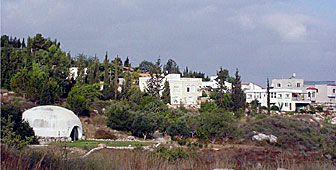Peace village throws light on Middle East conflict

A small Israeli-Palestinian village between Tel Aviv and Jerusalem suggests that both sides can live together in peace.
One of the first Jewish settlers in the village – founded in 1972 and today known as Neve Shalom (“Village of Peace”) in Hebrew and Wahat al-Salam in Arabic – was Swiss-born Evi Guggenheim.
“In the beginning the physical conditions were very hard,” Guggenheim told swissinfo.
“We didn’t have a road, we didn’t have electricity, and it was really pioneer work,” she adds.
Daoud Boulos, the Palestinian director of development at Neve Shalom, says the village’s primary school is a unique institution in the Middle East.
“It’s the only bi-national, Jewish-Palestinian school, where they actually go and study together in the same classroom, taught by two teachers, one Palestinian, one Israeli,” Boulos explains.
The village is also home to a “school for peace”, the venue for regular seminars on conflict resolution which visitors from outside the village are invited to attend.
“People from both sides meet here, stay for three days and engage in intensive seminars and workshops,” says Boulos.
Internal conflict
Though Neve Shalom is known as the village of peace, Guggenheim admits this does not mean it is an entirely conflict-free zone.
“As soon as two national groups live together, there will always be conflict,” Guggenheim says.
“But our way of living together is to try to resolve any conflict by addressing the problem. And so we develop a greater sensitivity to the other side. Sometimes it’s very hurtful, because we have opposite feelings, but the main thing is that the village belongs to both of us, in an equal way.”
Some 50 families – an equal number of Israelis and Palestinians – now live in the village and hundreds more are on a waiting list to move in if and when more land becomes available.
“We can only expand to 150,” says Boulos. “That’s our maximum because of land limitations.”
The village receives limited support from the Israeli government, but is mostly reliant on charitable donations. Guggenheim is currently on a two-year mission around Europe to raise funds for the village.
Living on an island
“Inside the village I feel totally free, but outside I’m really an outcast, someone who is suspected all the time, so it’s really a refuge for me,” Boulos says.
“I don’t want it to stay this way, because it’s not nice to live on an island, and you really want the entire system to be like this,” he adds.
But could the village act as blueprint for peace in the Middle East as a whole? Boulos believes this is unlikely.
“I think it only works on a village level, because given the present situation and with all these killings going on, it’s very difficult to talk about peace, co-existence and tolerance,” he says.
If the village is shedding any light on the present conflict, Boulos suggests, it is how both sides might peacefully coexist in the future.
“The situation has come to a state where it is totally hopeless and any talk of peace is a farce these days,” he says.
“I hope that if the Middle East problem is resolved, then people will look back and say ‘this place had a vision’.”
Model for coexistence?
Guggenheim agrees with Boulos that the village is “ahead of its time”, but believes the model of peaceful coexistence may one day be copied elsewhere in the region.
“People outside the village say ‘if it’s possible in Neve Shalom, then it must be possible’, and so we are really a sign of hope.”
Guggenheim, currently based in Zurich, says those charged with brokering an Israeli-Palestinian peace agreement could do worse than look to Switzerland as a model nation.
“When I passed the parliament building in Bern,” she says, “I talked to a Swiss-German soldier who spoke to me in French.”
“I turned to Daoud and said ‘you know, Switzerland could be a good model for us with its cantons and different languages’.”
“But I really hope it won’t take 700 years until we get there.”
by Ramsey Zarifeh

In compliance with the JTI standards
More: SWI swissinfo.ch certified by the Journalism Trust Initiative
You can find an overview of ongoing debates with our journalists here. Please join us!
If you want to start a conversation about a topic raised in this article or want to report factual errors, email us at english@swissinfo.ch.